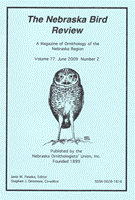Nebraska Ornithologists' Union

Nebraska Bird Review
Date of this Version
12-2008
Document Type
Article
Citation
“Fall Field Report, August-November 2008” from Nebraska Bird Review (December 2008) 76(4).
Abstract
Of interest to many is evidence of northward movement of species which generally summer on the Great Plains. In addition to White-winged Dove and Scissor-tailed Flycatcher, both slowly establishing as breeders in Nebraska, significant numbers of Glossy Ibis continue to be found, probably associated with major increases in numbers of White-faced Ibis. Perhaps the biggest surprise this late summer and early fall was the large number of Lesser Goldfinches reported from the southern Panhandle.
Less exciting by far, but worthy of attention were reports of several Mute Swans in the Omaha area, including a duo of juveniles, and a couple of sightings of Monk Parakeets, last known to breed in the state in 1998. Neither would be welcome additions to the breeding avifauna of Nebraska.
Notable western species found in the east included California Gull and Rufous Hummingbird, while Cassin's Kingbird and Cassin's Vireo crept eastward farther than usual. Most surprising in this group, however, was a Pygmy Nuthatch in Lincoln, a very rare vagrant in general. A mention also for Varied Thrush, a rare but annual visitor from way west, of which 3 were reported. Conversely, best eastern bird west was an immature Blackburnian Warbler banded in Scotts Bluff County.
Relative to last year's good numbers, both Red-breasted Nuthatch and Purple Finch were back to normal levels. At the time of this writing, no notable incursions of winter birds had been detected. Among regular migrants, Blue-headed Vireo, Nashville Warbler, and Orange-crowned Warbler appeared in excellent numbers; the migration period for Orange-crowned Warbler occupied all of 3 months. Strangely, Wilson's Warbler, usually abundant as a migrant in the west, was at a low ebb.
In the category of phenomena, the huge roost of Purple Martins in central Omaha, peaking at 35,000, was unprecedented as far as we know.
Finally, an identification note. Two vireos of the "Solitary" complex were banded, measured, and well photographed in Scotts Bluff County by Nancy Gobris of Nebraska Prairie Partners. Measurements indicated both were unequivocally Cassin's, but plumage characters indicated at least one may have been a Plumbeous.


Comments
Copyright 2008 Nebraska Ornithologists’ Union. Used by permission.